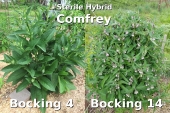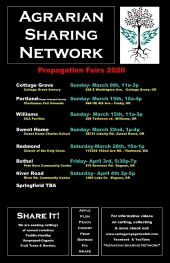For those of you looking for the broken links to the cover crops listed on soil food web, they can be found here:
https://web.archive.org/web/20180813120710/http://www.soilfoodweb.com/Cover_Plants.html
and here:
https://environmentcelebration.com/howto/low-growing-perennial-cover-plants-for-northwestern-us/
I've pasted these plants below, but please note that this list was originally created in 2014 and there are a lot of misspelled and/or outdated scientific names, so if you can't find them in a database like
https://plants.usda.gov, try googling them first to find their correct/alternate name. Same goes for some of the url resources (some of which may no longer exist).
Low Growing Perennial Cover Plants for Northwestern US
Ajunga Reptans (Carpet Bugle) Zones 4-9. Height: 2-3"
Swallowtail Garden Seeds (Swallowtailgardenseeds.com) 1-877-489-7333
Arctostaphylos edmundsii Carmel Sur Manzanita (Sur Manzanita)
Moose Creek Nursery.com 760-749-3216
Yerba Buena Nursery (yerbabuenanursery.com) 650-851-1668
Aubrieta x cultorum (Rock Cress) Zones 4-9. Height: 3-6"
Swallowtail Garden Seeds (Swallowtailgardenseeds.com) 1-877-489-7333
Seedaholic.com
Hardyplants.com
Campanula poscharskyana (Serbian bellflower) Zones 3-8. Height: 6"
Seedaholic.com
Ceanothus maritimus (Bluff California Lilac)(rare)
Las Pilitas Nursery (laspilatis.com) 760-749-5930
Bay Natives (www.baynatives.com ) 415-287-6755
Chrysanthemum paludosum (Creeping Daisy)
American Meadows 877-309-7333 Amazon.com
Outside Pride (outsidepride.com) 800-670-4192
Corethrogyne filaginifolia Silver carpet (Common Corethrogyne and California Aster)
Las Pilitas.com 760-749-5930 Larner Seeds (www.larnerseeds.com)
Dichondra - Zones 8-11. Height: 1-2".
Outsidepride.com
Erigonum caespitosum (Matted Buckwheat)
Pacific Rim Native Plant Nursery (www.hillkeep.ca )
Canada Geoscape Desert Nursery (www.geoscapenursery.com) 208-884-1251
Euphorbia maculate
Fragaria virginiana var. platypetala (Western Alpine Strawberry)
Las Pilitas Nursery (laspilatis.com) 760-749-5930
Festuca ovina L. (Sheep Fescue)
American Meadows (www.americanmeadows.com ) 877-309-7333
Herniaria Glabra (Green Carpet) Zones 5-8. Height: 1-3"
Seedman.com
Heuchera hirsutissima (Idyllwild Rock Flower)
Las Pilitas Nursery (laspilatis.com) 760-749-5930
Horkelia parryi (Parrys Horkelia)
Las Pilitas Nursery (laspilatis.com) 760-749-5930
Lemon Frost Thymeis - Zones 5-8. Width: 18" diameter.
Leptinella gruveri (Miniature Brass Buttons) Zones 7-9. Height: 1-2"
Lowe's Hardware
Leptinella minor - Zones 7-9.
Lysimachia nuinmularia (Creeping Jenny) Zones 5-8. Height: 2-6"
Amazon.com
Juncus phaeocephalus
Mazus reptans (Creeping mazus) Zones: 5-9. Height: 2-4".
Lowe's Hardware
Mentha requieneii (Corsican Mint) Zones 6-9, Height 6".
Monardella macrantha (red monardella, hummingbird monardella and Hummingbird Coyote Mint)
High Country Gardens (highcountrygardens.com) 800-925-9387
Nemophila Maculata (Five Spot) Amazon.com
'Nana' Creeping Cinquefoil (Potentilla neumanniana) Zones 4-6. Height: 1-3"
Nemophilia maculate
Oenothera californica (California Evening Primrose)
Plant world Seeds (
http://www.plant-world-seeds.com/)
Penstemon heterodoxus (Sierra Penstemon)
Northwest Native Seed, 17595 Vierra Canyon Rd #172, Prunedale, CA 93907
Las Pilitas Nursery (laspilatis.com) 760-749-5930
Potentilla aurea (Cinquefoil) Zones 4-8. Height: 2-6"
Plant-world-seeds.com
Pratia pendunculata (Blue Star Creeper) Zones 6-9. Height: 1-2"
Amazon.com
Sagina subulata 'Aurea' (Scott Moss) Zones 3-9. Height: 1".
Bluestone Perennials Nursery
Salvia sonomensis 'Hobbit Toes'
California Flora Nursery (calfloranursery.com) 707-528-8813
Satureja douglasii (Yerba Buena)
Amazon.com (Little Grove seeds)
Saxifraga Arendsil (Purple Robe) Zone 4-9. Height: 6"
Seedman.com
Sedum glaucophyllum (Cliff Stonecrop)
Amazon.com
Outside Pride (outsidepride.com) 800-670-4192
Seed man.com
Portland Nursery (portlandnursery.com) 503-231-5050
Sedum oreganum (Green Stonecrop)
Seed man.com
Portland Nursery (portlandnursery.com) 503-231-5050
Sedum 'Silver Moon'
Portland Nursery (portlandnursery.com) 503-231-5050
Selleria microphylla (Fine TIde Turf) Zones 8-10. Height: 1".
Thymus pseudolanuginosus (Woolly Thyme) Zones 5-9. Height: 2".
Thymus praecox 'Reiter's Red' - Zones 3-8.
Thymus reiter (Reiter Creeping Thyme) Zones 4-9.
Thymus serpyllum (Creeping Thyme, Mother of Thyme) Zones 4-7. Height: 2-4"
Burpee.com
Amazon.com
Swallowtailgardenseeds.com
Seedman.com
Trifolium repens (Dutch White Clover) Zones 3-10. Height: 3-5"
Seedman.com
Veronica Prostrata (Prostrate or Rock Speedwell) Zones 4-8. Height: 4-6"
Seedman.com
Wallowa Mountains Mossy Sandwort (Desert Moss) Evergreen. Zones 4-8. Height: 1".
Zinnia grandiflora (Prarie zinnia) Zones 4-9. Height: 4"
Plantsofthesouthwest.com
_________________________________________________________________________________________________
Low Growing Perennial Cover Plants for Northeastern US
Achillea tomentosa (Woolly Yarrow). Zones 4-10. Height: 6-12 inches.
Arctostaphylos uva-ursi (Bearberry). Zones 2-6. Height: 6-12 inches.
Chamaemelum nobile (Roman Chamomile). Zones 4-6.
Hypericum reptans (Creeping St. John's Wort). Zones 5-9. Height 4-12 inches.
Origanum vulgare (Oregano). Zones 4-9. Height: 4-12 inches.
Sedum spurium 'Fulda Glow' (Fulda Glow Stonecrop). Zones 3-9. Height: 4-6 inches
Sedum spirium 'Tricolor' (tricolor Stonecrop). Zones 2-9. Height: 4-6 inches.
Sedum 'Vera Jameson' (Vera Jameson Stonecrop). Zones 3-9. Height: 10-12 inches.
Seudm spurium 'John Creech' (John Creech Stonecrop). Zones 3-8. Height: 1-4 inches.
Sedum sieboldii (Stonecrop or October Daphne). Zones 3-9. Height: 6-12 inches.
Sedum reflexum 'Angelina' (Angelina Stonecrop). Zones 3-9. Height: 3-6 inches.
Sedum 'Bertram Anderson' (Bertram Anderson Stonecrop). Zones 3-9. Height: 6-12 inches.
Teucrium spp. (Germanders) T. Chamaedrys 'Prostratum' (or 'Nanum'). Zones 5-8. Height 6-8 inches.
Teucrium spp. (Germanders) T. Montanum. Zone 7.
Thymus praecox subsp. arcticus 'Lanuginosus' (Woolly Thyme). Zones 5-9. Height: 1-2 inches.
Thymus praecox subsp. srticus 'Coccineus' (Crimson thyme). Zones 5-8. Height 1-3 inches.
Thymus praecox subsp. arcticus 'Quinquecostatus', 'Albus', Zones up to 4. Height: 4 inches.
Thymus pulegiodes, T. sephllum (Mother-of-Thyme). Zones 4-8. Height: 6 inches.
______________________________________________________________
Hardiness Zone 3 (temperatures to - 40 degrees F)
Antennaria parvifolia Nutt. (Nuttall’s)
*-Antennaria plantaginifolia (L.) Richardson (woman’s tobacco) Packet $2.50 Prairie Moon Seed
Antennaria dimorpha (Nutt.) Torr. & A. Gray - low pussytoes
-Antennaria neglecta (Prairie Pussytoes) Praire Moon Seed Packet $2.50 1/8 oz $30.00
*-Aster macrophyllus (big leaved aster) Prairie Moon Seed Packet $2.50
Antennaria umbrinella Rydb. (umber pussytoes)
Dianthus armeria L. (Deptford pink) *many other species but not this one
-Fragaria virginiana Duchesne (Virginia wild strawberry) Prairie Moon Seed Packet $2.50 *many other species but not this one
Fritillaria pudica (Pursh) Spreng. (yellow fritillary or yellow bell) *many other species but not this one
* Geranium maculatum (spotted geranium) Prairie Moon Seed Packet $2.50, 1/8 oz. $15.00
Lesquerella alpina (Nutt.) w. Watson var. alpina (Alpine Bladderpod)
Leucocrinum montanum Nutt. ex A. Gray (Mountain Lily, sand lily common starlily)
* Lewisia rediviva Pursh var. rediviva (bitter root)
Linnaea borealis L. (twinflower)
*Lysimachia ciliata L. (fringed loosestrife) Prairie Moon, Seed Packet $2.50
*Oenothera caespitosa Nutt. ssp. montana (Nutt.) Munz (evening primrose, desert gumbo lily)
Oxytropis lambertii (Purple Locoweed) Prairie Moon, Seed Packet $2.50, 1/8 oz. $12.50, 1/4 oz. $20.00, 1/2 oz. $35.00, 1 oz. $60.00, 1 lb. $900.00. *many other species but not this one
Penstemon eriantherus Pursh var. eriantherus (fuzzytongue penstemon) *many other species but not this one
Phlox hoodii RIchardson ssp. viscidula (Wherry) Wherry (Hood’s)
Phlos hoodii Richarson ssp. muscoides (Nutt.) Wherry - aka Phlox bryoides (Moss) *two other species but not this one
Physaria didymocarpa (Hook.) A. Gray (common twinpod)
* Sedum lanceolatum TOrr. ssp. lanceolatum (spearleaf or lance-leaved stonecrop)
Townsendia hookeri Beaman (Hooker’s Townsend daisy)
Vicia americana Muhl. ex Willd (American vetch)
Viola nuttallii Pursh (Nuttall’s yellow prairie violet)
*
http://www.jelitto.com






















